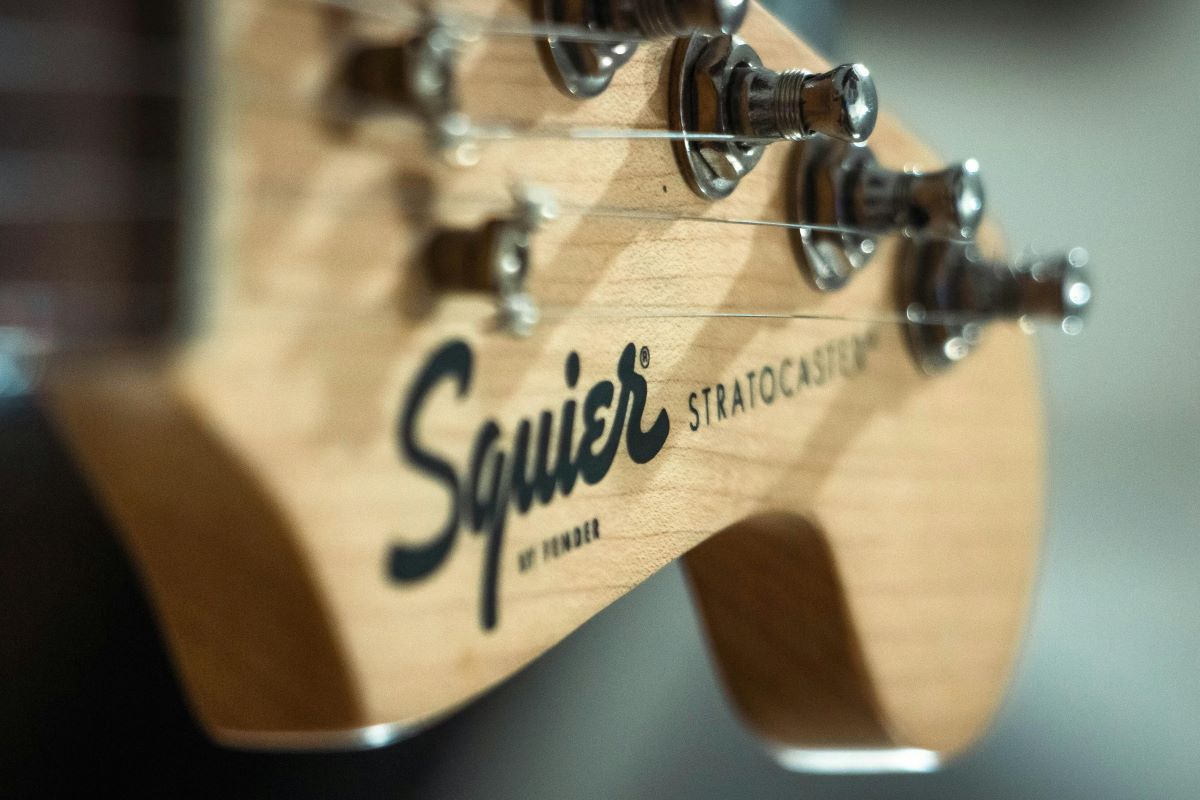Steve Rothery is without a doubt one of the most underrated guitarists around. His highly emotive, melodic, and atmospheric playing style has been a cornerstone of Marillion's sound and instrumental in creating their vast number of hit records.
Not many bands have the insanely loyal fan base that Marillion has acquired over the past 40-odd years. In fact, they were the first band in history to crowdfund an album!
That’s right, and it was eight years before platforms such as Kickstarter even existed. All the way back in 2001, the band emailed 12,000 fans who paid £15 (around $20) each for the band’s next album, Anoraknophobia, before it was even recorded.
And a lot of those highly loyal fans are guitar players who realise just how talented Steve Rothery is.
But why does Steve Rothary play a Squier Starocaster and not a Fender Stratocaster? Well, we’re about to find out, plus we’ll take an in-depth look at what modifications have been made to the guitar, and what parts you can use to make your Strat sound amazing.
But before that…
What makes Steve Rothery such a great guitarist?
The Song Comes First
Rothery writes guitar parts that fit perfectly within the emotional context of each song, always prioritizing melody over flashy technical playing. This produces solos and riffs that are lyrical, emotionally resonant, and memorable.
They are also often an extension of the song’s narrative, such as in tracks like “Easter” and “Kayleigh”.

Textural Tone Creation
Steve is world-renowned for both his rich, harmonious, clean tone and his massive, sustain-heavy lead tone. Both of which are usually highly effected, adding various choruses, delays, and reverbs to create the expansive, atmospheric soundscapes we love so much.
He favors guitars such as his '80s Squire Stratocaster, which I’ll be taking an in-depth look at next. This is paired with amps that range from his trusty pair of Roland JC-120s to a Marshall Major into a 4x12 Marshall cabinet.
For newer material, he uses a Groove Tubes Trio preamp with a Groove Tubes power amp, through a Marshall 4×12 cabinet loaded with Celestion Vintage 30s. This gives him a broad sonic palette to create his distinctive tone, from warm vintage to classic Roland transistor for additional clarity and expansive stereo chorus.
It’s all about Emotion
His playing is always deeply expressive, focusing on dynamics rather than flash. He usually spends his time building a solo gradually, using bends, slides, and subtle vibrato to create the perfect mood for a particular song.
One of his greatest strengths is his ability to effortlessly shift from delicate, clean arpeggios to soaring, distorted leads, adding a mesmerising level of emotion to a song in a heartbeat.
Technicality without the Flash
While he’s most definitely not a shredder, Rothery is a highly accomplished technical player. But he’s a lot more subtle than most. His skills shine in his precise picking, his incredible control of bends, the way he adds vibrato, as well as his masterful use of effects.
Let’s now move on to his beloved Squier Stratocaster…
The late 80s to the late 90s were a very important decade for Marillion. It marked the end of the Fish era and the beginning of the rest of their career with a new singer, Steve Hogarth.
Moving on after having such a charismatic singer as Fish can be difficult, but the band knuckled down and found a fantastic new vocalist/frontman and got back to work as normal.
However, one thing did change as Steve Rothery moved away from his Yamaha SG-2000 and used his Squier Stratocaster for the majority of recording and live duties. And he loves the guitar so much that he still uses it live for most of the older songs to this day.
But what makes this Squier Stratocaster so Special?
Squier Strats are often looked down upon. They can’t be that good; they are just a cheap beginner's guitar. But not all Squier Strats are created equally. Especially the early ones made in Japan in the 1980s.
At the time, Fender had a problem with budget competition. They needed to find a way around the growing number of high-quality, low-cost Japanese Strat and Tele copies that were eroding the company's market share in the US and Europe.
So they started manufacturing guitars in Japan under the ‘Squier’ brand to beat the competition at its own game.
These guitars had to be of good quality and better than competing ‘copy’ companies’ guitars. So, Fender made sure that the materials used and the build quality was excellent; they even used US-made pickups in a number of the early guitars.
The results were stunning…
…guitars that many think are better than a lot of the US-produced Fenders of the time. If you can find one at a reasonable price, snap it up; you won’t regret it.
Unfortunately, over time, economies have crept into the manufacturing of Squiers, and the ones produced today are not as good as the early ones. But they are still excellent guitars for beginners and those on a budget.
And the good news is that you can do exactly the same as Steve and upgrade any part of your Squier or any other Strat (or whatever else you play) that you’re not happy with for a higher-quality one.
So let’s go through his guitar…
Part by Part
Steve's current main live guitar is a highly modified mid-1980s Squier Stratocaster SQ manufactured in Japan which he bought new for £160 (around $205). Over the years, he has had it customized to suit his playing style and tonal preferences.

Tremolo System
Originally, the guitar featured a standard 6-point Stratocaster tremolo system, as found on the majority of SQs. Rothery upgraded this to a Kahler tremolo, a locking vibrato system that was popular in the 1980s for its stability and tuning reliability.
The Kahler had its own distinct design that differentiated it from its great rival, the Floyd Rose vibrato system, and many guitarists believe the Kahler to be the better option when you get accustomed to using it.
However, the Floyd Rose proved to be more popular, thanks to clever marketing and use by the likes of Eddie Van Halen, etc. and is more commonly found on guitars these days, although Kahler trems are still available.
Suggested Upgrade - Guyker GKS1000-GKS4000 Double-locking Tremolo With Lock Nut
Pickups
In the 80s, the stock pickups were removed and replaced with EMG active pickups to provide a high-output, clean, clear tone. Steve is also a big fan of Lindy Fralin pickups and has installed them in a number of his other guitars.
Locking Nut
The guitar features a Bill Edwards Finger Tite locking nut, an innovative locking mechanism that was designed to enhance tuning stability, especially when used with a Kahler tremolo.
As opposed to the usual locking nut design that requires an Allen wrench, the Finger Tite has three metal "flaps" on hinges that hold the strings securely when pushed down. They are no longer in production.
Suggested Upgrade - Guyker XS001 Guitar Locking Clamp Behind the Nut – CNC Machined
Neck and Frets
The guitar has a maple neck with a maple fretboard and has been refretted with Rothery’s favorites, medium jumbo frets.
While on the subject of the neck, many guitarists would have swapped the neck out for one with Fender on the headstock. Most Fender Strat and Squire Strat necks are interchangeable with zero modifications.
However, Steve isn’t interested in showing off, so the Squier logo on the headstock wasn’t an issue. He prefers to let what he plays on the guitar do the talking, not what’s written on it.
Electronics and Controls
The guitar still has the standard Stratocaster controls - a volume, two tone knobs, and a 5-way pickup selector.
The electronics have been upgraded to support the active EMG pickups, ensuring low noise and high clarity, plus making room for the 9V battery compartment for power.
Tuners
Japanese Squier Strats from the 1980s were usually fitted with standard Fender-style tuning pegs. These were reliable, high-quality tuners, but over time, they do need replacing.
Suggested Upgrade - Guyker GK-D-07SP Dopamine Color Lock String Guitar Machine Heads Tuners
Body
The body is either solid alder or solid basswood, both of which were commonly used for Japanese Squiers of the era.
If you want to take an even deeper dive into the equipment and tones of Steve Rothery, check out this excellent interview he did on The Pedal Show:
Wrapping it Up!
There you have it, my in-depth look at the modifications made to Steve Rothary’s Squier Stratocaster.
The guitar is an integral part of Steve’s versatile, effects-driven tone and is perfect for his shimmering arpeggios and soaring leads. The modifications have taken a good guitar and made it even better, enhancing tuning stability and tonal clarity.
So, get creative with your guitar and do some upgrading to make it exactly what you need for your sound. All the high-quality parts you need are available from Guyker.



Share:
What does a Professional Guitar Setup include, and when is it necessary?
Is it Better to buy a Cheap Guitar and Upgrade, or buy a High-End One?